This week we had the pleasure of talking to Sundaram Tagore – international gallerist and art historian – on topics including the Singapore art scene, the psychology of space at an art fair, and why he has been given the confidence to bring innovative artists to Singapore and to Art Stage.
As I entered Sundaram Tagore Gallery to meet Mr Tagore himself, my eardrums sprang to life. I was greeted with the mystical and wondrous sound of chiming bells, the soft resonance of gongs, and then a rhythmical crescendo of mesmerising sound. I was experiencing a sonic artwork by Taylor Kuffner, which draws on the thousand-year-old tradition of Indonesian ‘Gamelon music’, mixed with modern robotics. Placed in several locations inside and outside the gallery, are the robotically coordinated bells we hear all around us. Performing it’s own viscerally-powerful dance, this artwork seems alive with a character and a voice. During the conversation which unfolds below, the soft chiming continued as the kinetic sculpture hummed and sang to us.

Sundaram Tagore, with artwork by Taylor Kuffner
Nicola Anthony: At Art Stage Singapore last week, the Sundaram Tagore booth presented a roster of international painters, sculptors and photographers sharing a passion for cross cultural dialogue. Did any genres of art or artist seem to capture the visitors in particular this year?
Sundaram Tagore: We have participated in Art Stage since the very beginning, and I think this year was the biggest success for us, although in the very first year we did quite well, the second year was not so good, but suddenly things changed – large numbers of people showed up and were attracted to our space. Fernando Botero’s work did very well, he was a new one for us and we also did exceptionally well with Hiroshi Senju, Annie Leibovitz, Edward Burtynsky, and Ricardo Masal.
NA: Was there anything in particular you found better this year, for example was it busier? Perhaps more of the right kind of people?
ST: There are a couple of things that have happened with Art Stage – one is that last year the orientation was really off. As you walked in there was a huge wall which disorientated people. If visitors don’t connect immediately, it’s too overwhelming psychologically. With the curatorial process – when you display works of art – it’s not just slapping works of art on a wall: You are creating a narrative, creating a story, visually attracting people’s attention. So if you put up a huge painting on an enormous wall, you are telling them “this is a wall” – so that ‘wall mentality’ means people get very exhausted with museum fatigue from the very beginning…but if you make it welcoming, then the equation changes, and I think that’s what happened this year. They also did enormous marketing, such that my clients staying in hotels found their VIP tickets in their room – brilliant idea.
NA: So it’s about the journey. I did notice the Sundaram Tagore booth was an interesting space, with lots of alcoves and areas where artwork appeared as you walked around inside it or turned a corner. Did you have a curatorial plan or was the booth planned more as a taster of what’s been shown at Sundaram Tagore?

Sundaram Tagore Gallery installation view at Art Stage Singapore, 2013
ST: There is absolutely a curatorial plan, we have been to perhaps more than 100 fairs since we opened our doors, so we know that you have to have some openings in some areas, but you can’t reveal everything in one shot. If you have a completely open booth, amongst the 160 booths up there, why do visitors need to come in if they have already seen it? So you need to weave it in and out, create a little bit of hide and seek. Then you can attract people with certain really iconic pieces – because when you recognise something, you want to come in, it’s like an individual that you are meeting, and if you know that person you want to come in and greet them. That’s the psychology of space at an art fair. We create a maquette in our art fair department in New York, and we play with these forms. We see what’s available to create around the artworks that we want to display – and that’s how we curate the show.
NA: It’s really fascinating to understand how that sense of intrigue was created on your booth. As the fair was quite international, I am interested to also find out how you feel Sundaram Tagore fits into the Singapore art scene.
ST: The fair is very international, but what I really like about it is that they are creating more of an identity, and that happens to be more Asian. If you look at other fairs such as Art Basal, Miami Basal, even Hong Kong Art Fair, you see that the thrust is more or less everything that goes on in the west, and when they bring it over here – it’s still the same thing. So if you are an art aficionado, then you don’t care for it because you want something more specific to the culture, that’s the reason you have come here. Elsewhere, you have other fairs that are very regional, so I think they are developing a kind of identity which is more South East Asian. Within a global context we saw White Cube and a whole range of other galleries there that are not specific to SE Asia, however, the thrust happens to be South East Asian – and that’s our identity, it’s the reason to come to art stage.
In the context of our gallery in Singapore, of course we are not a local gallery, we are probably amongst the one percentile in the world in terms of multiple locations. But we have this dialogue – a multicultural, East-West dialogue – which is the very basis of our identity in a globalised world. We created that idea in 1999 before we knew it was globalisation. We created that purely because I had lived abroad, I was living in the West but coming from East, and that was my reality. I wanted to bring together a global community of artists, with the basis of intercultural dialogue. That is what I felt globalisation was – that point of intersection where the energy exists. The same energy exists in, for example, the sonic work by Taylor Kuffner. It takes tradition and tries to preserve it but not in a static sense. He brings in robotic technology, so that a tradition-tension exists, and that’s why it becomes interesting. If it was just the Gamelon music in a tape recorder, it would have been different – but instead, something unique is happening here.
NA: I’m interested in where do you see the Singapore art scene heading. Of course there was a reason and an opportunity for you to set up a gallery here in 2012, has it been what you expected?
ST: It has been 5 or 6 months now, and we are very happy with it. We have opened multiple locations in different parts of the world, so we know what to expect. You cannot have false expectations because it’s part of an organic growth process, but ultimately everything depends on the Singaporean population. If the Singaporean population feels they need to go to malls, and spend all their time shopping, then we won’t exist. But if they value culture and say “I want my children to go to museums and art galleries”, if they want them to be cultured individuals, then we will exist. The fact that we got this incredibly warm response, the fact that people are talking about the show, that gives us confidence to be here and bring more of these artists to Singapore.
NA: Singapore is quite individual in that there are guidelines to follow in terms of the art world. It is sometimes difficult for artists to be free in what they express. Would you be able to comment on how you think this affects your own gallery and the art scene here as a whole?
ST: I have had conversations with the directors of Gillman Barracks, but they don’t interfere with our works at all. We showed them our programming when we were invited to apply, and based on that we got accepted and we are now following the programming which is the artwork that we are interested in. They don’t tell us what to show, so that doesn’t apply to our organisation.
NA: That’s good to know because sometimes it’s difficult to know how a gallery chooses their artists. And the artists that you show – I think lots of them you have been working with for many years?
ST: Yes, it’s building a relationship, because when an artist works with you, they can give you a million dollar piece of art – so they have to trust you. The relationship is an ongoing process and certainly doesn’t happen overnight.
NA: Many of these artists have come to feature in the current exhibition, ‘Home and the World’, which looks at concepts of home, globalisation, the world outside and the ties of culture. Was there a particular inspiration for this show or did it come together more organically? How did you select the artists?
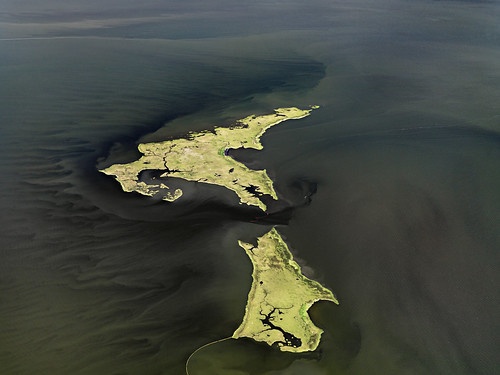
Edward Burtynsky, Oil Spill #14, Marsh Islands, Gulf of Mexico, June 24, 2010, Chromogenic color print, 39 x 52 inches Photograph © 2010 Edward Burtynsky
ST: The inspiration is this idea of ‘Home’. What is home? In a globalised world where everyone is moving around, the home becomes your passport and your education, and you travel from country to country. I’m based right now in 3 or 4 different countries simultaneously, so I shuffle every week! In that context, home is where the heart is – what are you looking for? From the artistic point of view, what is this home? We are trying to preserve something that is really important – such as what Taylor did with his work. All of these artists are finding a centre – home becomes much more metaphysical, rather than a physical space.
NA: I guess that can also be one of the main ‘missions’ for artists, to find themselves or their sense of home. We have talked about Taylor Kuffner and his amazing Gamelatron Project already, but I have been captivated – it’s a very different and immersive artwork, it exists both inside and outside of the gallery space. How have people reacted to this sound installation?
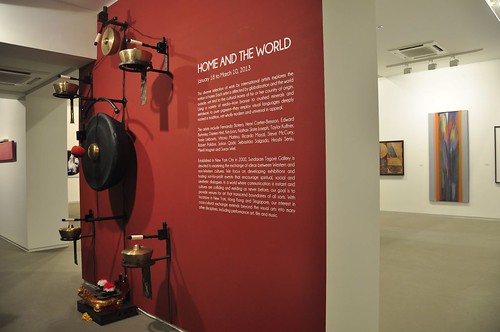
Taylor Kuffner, The Gamelatron Jalan Jiwo, 2012, Kinetic Sculpture Installation
ST: We were surprised that at Art Stage people recognised us because they had heard this sound. People were coming to our booth purely because they had experienced this, and we started conversing about that. There has been a huge – absolutely enormous – response. We have also had ideas from our National Arts Council, even from MRT, who thought it would be great to place the artwork there – these are questions Taylor is dealing with.
NA: So maybe we will see it on the MRT one of these days?
ST: Yes, that would be wonderful!
NA: The themes of home, origins and identity seem to be key to Singapore and Asia currently – with important museum shows such as the Collector’s Show at SAM also picking up on memory, the “Weight of History”, and exploring how the past of our home country has shaped the present; via memories, traditions, culture and values. Why do you think these themes are resonating so much in current times? Is this different between East and West?
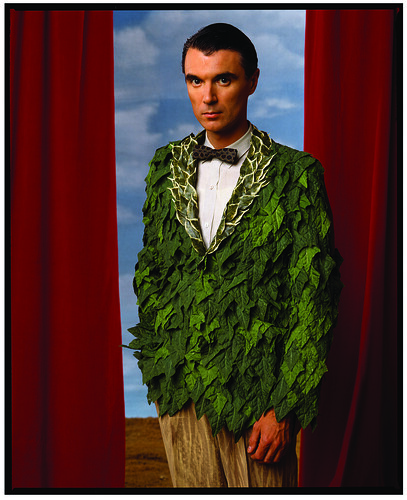
Annie Leibovitz, David Byrne, Los Angeles, 1986, archival pigment print, 40 x 60 inches. Photograph © Annie Leibovitz
ST: I think ultimately everything stems from this idea of tradition and tension. If you come from East or West it doesn’t matter, it’s a preservation of culture and what is of essential value to you. This is morphing because modernisation eradicates and wipes out tradition. The very base of modernism is a rejection of tradition, but we don’t live in a modern age anymore we live in a post-modern age. The postmodern accepts this idea of tradition coexisting with modernity, and that you have a negative and positive – such as environmental damage and environmental solutions. Both co-exist and there is a contradiction that the modern age could not accept because of their progressive thinking pattern: one linear way of thinking of a utopian world. We are much more realistic, so idealism goes hand in hand with realism – accepting that you can be a solution to the environmental problem, but you are also the cause of that.
Not everything about tradition is good, it can be oppressive, so you need to get rid of that and become a modern individual, but you also need to preserve something that is so valuable – because it’s what creates us as a human beings. So that’s what the story is about – the humanity of it.
NA: On your opening night, the artist Kim Joon made an impression on me. I realised I had seen his work before at London’s Saatchi Gallery, and his work also jumped out at me more recently at Art Stage. I found out that his images of fragmented ceramic body parts with tattoos, emblems and iconography, are actually created digitally using software as a tool. They make for very slick pieces, I wonder if you had any thoughts on this new technique?
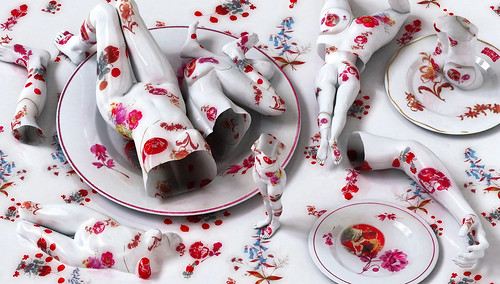
Kim Joon, Drunken-Gone With The Wind, 2011, digital print, 47.2 x 82.7 inches
ST: He is a young artist, and he has caught the imagination of the people with the images that he produces. Saatchi picked him out and showed him in the Korean Eye show. He deals with the consumer culture that we live in: graffitti, tattoos, the forbidden world and the commercial aspect of it. Body parts are all sculpted on a flat surface, using a 3D programme, a Disney programme. Instead of using a brush, he is actually using the mouse to create the shades. With computer technology, he deals with all the things that we are attracted to in a contemporary society. In this way, the exhibition also deals with the physical-spiritual contradiction and resolution – that you cannot be spiritual unless you also know your physique. The physical side of it will take over if body parts are not working well or are broken. With pain, how can you think about the mental? That side also has to be taken care of. It’s a narrative between them both.
NA: Which other artists or artworks here in the gallery today can you give us a deeper insight into?
ST: Let’s talk about Mexican artist, Ricardo Masal. His work is to do with a trilogy of his Mexican culture, called Red Queen of Palenque. That comes from his Mexican heritage, then there is Odenwald, showing his Germanic associations with the Peace Forest, and finally, Mount Kailash – which also happens to be the abode of Shiva. In this last part of the trilogy that we show here, he has circumambulated that place, which caused a psychological transformation – from a physical, mundane space to a spiritual space. When you experience that, there is a transformation, and something happens to you. In that painting, there is a disintegration of the prayer flags, and a melting of the show against the black – so there is a Yin and Yang, black and white, East and West connection existing in a metaphoric sense.
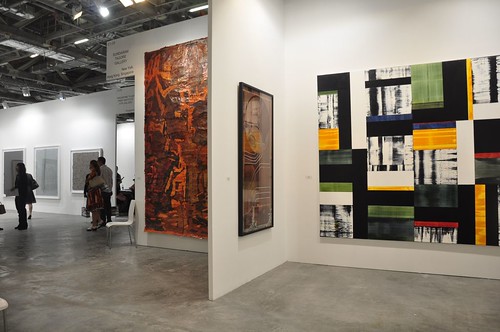
Sundaram Tagore Gallery installation view at Art Stage Singapore, 2013
ST: With the prayer flags that you see, when they disintegrate, that’s when the prayers are at their most efficacious – just like when our ego is dissolved and we can become true human beings. When we say ‘I did this’ then we are lesser in terms of human comprehension and intelligence, because ego is taking over. Masal learned that we should attempt to merge with the totality of the universe – which is from the Buddhist culture, Hindu religion and Eastern tradition: that we are part and parcel of the totality of the universe. This means that stomping on the grass is not hurting the fly alone – it’s hurting the self in the process. We are part of an equation. Mount Kailash made him aware of that, and that’s what he’s trying to reveal in this painting. It’s about life, death and redemption.
NA: It sounds like a very personal piece about this artist’s journey.
ST: It really is – and then he ties it with his own culture to show that it is the ultimately human quest, it’s universal.
NA: Sundaram Tagore, you have been most inspiring and enlightening to talk to – we have covered topics from crowd flow around an art fair to the flow of life through the totality of the universe. Thank you so much for giving us and our readers this insight. We look forward to speaking with you again soon, for our next exclusive article which will delve a little more into the secrets behind the work of one of today’s most inspirational artists – Taylor Kuffner.
Watch this space for the next article in this two part series: Sundaram Tagore: An insight into the sonic universe of Taylor Kuffner. In the meanwhile we urge you to visit the exhibition on until March 10th at Sundaram Tagore Gallery, Gillman Barracks.
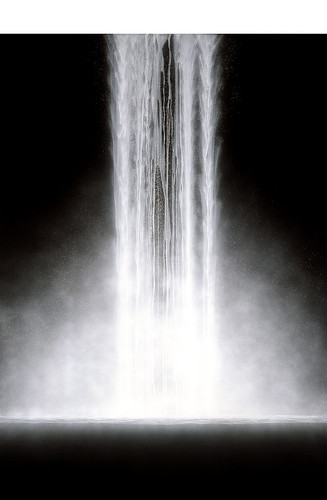
Hiroshi Senju, Waterfall, 2012, natural pigments on Japanese mulberry paper, 102 x 71 9/16 x 1 3/16 inches
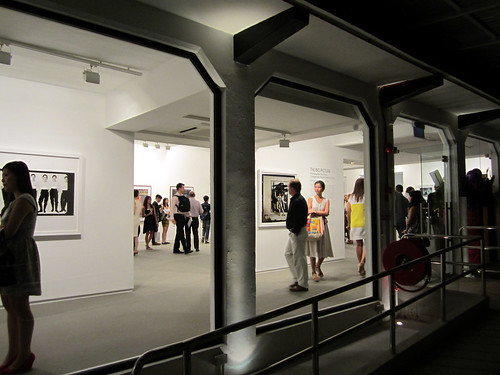
Installation view at Sundaram Tagore Gallery Singapore, 2012
texts by Nicola Anthony
Editor’s Note: Artist and writer working in London & Singapore, seeking to discover things which make her mind crackle with creative thought. Creator of art, thoughts & words.

Nicola Anthony
Artist and writer working in London & Singapore, seeking to discover things that make her mind crackle with creative thought. Nicola also directs the Edible Art Movement.